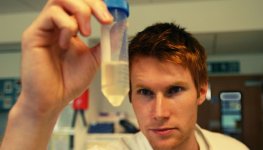About Me
After having spent three joyful years frolicking in Warwick's rich intellectual (and, ahem, social) pastures, and emerging with a Physics BSc tucked securely beneath my arm, I suddenly found that my feet were no longer on any path that I could discern. Apart from a stretch of highly rewarding and useful summer work, my road ahead was blocked by a tangled jungle of uncertainty and possibilities.
After what seemed like an eternity of job hunting toil, but was actually only a couple of months, I came across MOAC. MOAC seemed to offer a way for me to explore an interest in the life sciences that I had really always harboured. I had also developed a serious interest in complexity and self-organised behaviour of the kind observed in ant colonies, termite nests, the swarming of bees, the growth of cities, the conscious mind and countless other examples nature has to offer. It seemed to me that there was clear link between all these things, and that they were all really manifestations of the same underlying idea. An idea that proves elusive because of the way that the rules and interactions occur at a local level but lead to astonishingly organised global behaviour. I wanted to tackle that idea, and tame it, so that we may understand how it is we are able to live and think. If we knew how nature did it, maybe we would be able to take the solutions she had developed through billions of years of evolution and apply them to our own technological problems.
MOAC, almost uniquely, offers the training to tackle such lofty dreams. The training is intense and you constantly find yourself completely out of your depth and having to deal with it. I think my MOAC colleagues would agree when I say that it is a true test of one's integrity. The workload is about as heavy as it could be and the skills acquired are broad and numerous. I have found there to be a great deal of freedom to explore and control one's own intellectual development, a lively and open atmosphere actively encourages it. I have gone from studying several different aspects of an intriguing organism called Myxococcus xanthus, which displays this complex organised behaviour on a number of levels, to an interest in representing biochemical signalling pathways in a variety of ways. These include ordinary differential equation models, extensible markup languages (XMLs) specifically tailored to biological requirements, and most recently, concurrent process calculi. It seems to me that this latter approach, or a related logic based approach, holds much promise. It handles biological molecules in a conceptually appealing manner and allows them to interact in ways that provide a good abstraction for the ways they interact in real life.
I have just finished a PhD looking at modelling the pheromone signalling pathway in Schizosaccahromyces pombe. A crucial component of the pathway is the signal receptor protein, which is of the G-protein coupled receptor family. These are a diverse family of proteins found across many domains of life, in particular, humans. A human cell contains many GPCRs which are the signal receptors in pathways that regulate myriad aspects of cellular behaviour and adaptation. A large proportion of drugs on the market today target these GPCRs. In order to make safer and more effective medicines we need to know more about the role of these proteins in their signalling pathways. Schizosaccahromyces pombe provides an experimentally tractable system in which to study them.
I am currently working as a post-doc at the Albert Einstein College of Medicine in New York City. My PhD. deepened my interest in life sciences and I have moved from studying signalling in yeast to studying the carcinogenic mechanisms of human papillomavirus (HPV).
Academic interests aside, I like to keep active; whether its parkour, hiking, skiing, biking, swimming, jogging, or squash; as Einstein said, "Life is like riding a bicycle, to keep your balance you must keep moving"...

